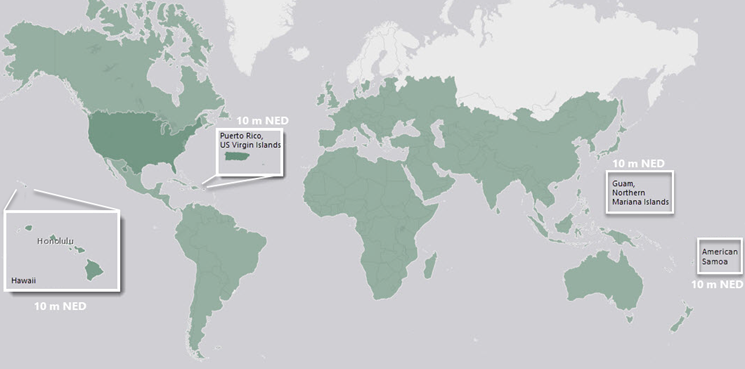Hydrology analysis data coverage
The data being operated on are maintained by Esri and used in the hydrology analysis service requests. A primary benefit of using these data sources is that a lot of the hard work has already been done, freeing you up to just work on performing analysis instead of having to worry about compiling, processing and storing very large datasets of continental and global scales on your local machine or network.
Data coverage
The following map illustrates the types and coverage of data available for hydrology analysis:


An interactive map is a also available for exploring the source data further.
Data source details
The available source databases are:
- 90m HydroSHEDS for the world between 60 degrees north and 56 degrees south, plus some areas in Canada and Alaska north of 60 degrees.
- US 30m, which is derived from the 30m National Elevation Dataset (NED) for the continental United States.
- US 10m, which is derived from the 10m, National Elevation Dataset (NED) for the continental United States, but only for Hawaii, American Samoa, Northern Mariana Islands, Guam, Puerto Rico and US Virgin Islands.
Esri processed the source data and derived additional layers required to support high performance and scalable watershed delineation and downstream trace requests. The source data were the same elevation, Hydrologic Unit boundaries, streams and waterbodies that were used by the Environmental Protection Agency and US Geological Survey to produce NHDPlus V2.1 for the conterminous United States (released in 2012). Sinks were filled unless they fell within a Watershed Boundary Dataset (WBD) closed basin, ensuring that flow will only terminate in endorheic regions. The Esri hydroconditioning process differs from the NHDPlus V2.1 process; therefore the resulting watershed delineations and downstream traces do not always match those from NHDPlus V2.1.
The 90m resolution HydroSHEDS data, which was produced by the World Wildlife Fund Conservation Science Program in partnership with the U.S. Geological Survey, the International Centre for Tropical Agriculture, The Nature Conservancy, and the Center for Environmental Systems Research of the University of Kassel, Germany. HydroSHEDS is generally accepted to be the most comprehensive global hydrological data set.
Additional information
For more information about the NHDPlus V2 or HydroSHEDS data processing, please email HydroTeamRC@esri.com.